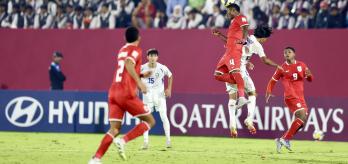The annual competition will be hosted in Doha’s Aspire Zone from 2025 to 2029, allowing for a degree of consistency in the environment and conditions when analysing the tournament over the next five consecutive years.
In this article, our Football Performance Insights team examine the early findings from the enlarged group stage, which saw a total of 72 games played across the 12 groups of four teams, with each team playing three matches. Initial indications show that teams are covering, on average, 7km more per 60 minutes ball-in-play time (122km to 129km), with sprint distances rising from zones 4 and 5 (>20km/h and >25km/h), rising from 7.3km to 8.3km, compared to 2023.
Early themes
Throughout the group phase, FIFA’s FPI discovered a wide range of trends, such as:
-
a slight increase in winning margins compared to the FIFA U-17 World Cup 2023™ in Indonesia;
-
efficiency in front of goal improved, with more on-target attempts at goal and a higher goal-conversion rate;
-
an increase in goals scored in the opening 15-minute periods of both halves;
-
an increase in playing minutes for 16-year-old players;
-
a high volume of goal contributions from substitutes;
-
more long throws in the top 25% of the pitch being delivered direct to the penalty area; and
-
increases in the total distance covered by teams and in sprinting/high-speed running distances covered.
Goals scored analysis
Despite the expanded number of teams, scoring remained identical to Indonesia 2023 at 3.5 goals per game, with the average winning margin rising slightly from 2.7 goals to 3.0 goals. It must be noted that teams across the 48-team spectrum are at different stages of their development, with five nations (Fiji, Republic of Ireland, Zambia, El Salvador and Uganda) making their debuts at a FIFA U-17 World Cup. The impact of the increased exposure to playing at this level will take time to measure, but of the five debutants, three — Republic of Ireland, Zambia and Uganda — advanced to the knockout stages.
An increase in finishing efficiency is also noted, with on-target attempts at goal increasing from 34.4% in 2023 to 36.8% at the 72-game mark in 2025. A slight increase (1.7%) in converting on-target attempts at goal to goals is also recorded.
Timing of goals
In the opening three rounds of this U-17 World Cup, our Technical Study Group noted apparent high-intensity starts to both halves of games — an observation that is supported by our data — with an increase of 4.3% in goals scored within 0-15 minutes and a rise of 4.4% in the 45-60-minute time sectors. Interestingly, goals scored in injury time of both halves decreased.
Squad usage
The average squad age remained consistent with the FIFA U-17 World Cup 2023, at 17 years 4 months; though several CAF and AFC teams fielded very young squads. As a result, minutes played by 16-year-olds rose from 16% to 21%.
There were variances in the number of squad players utilised by different nations, with seven teams giving minutes to 20 or more players in their panel — Argentina being the only side to use all 21. Debutants Uganda only played 15 of their 21 players during the group stages, while Qatar, Egypt, Bolivia and Belgium gave minutes to 16 of their squad members.
The impact of substitutions
A small reduction in the number of substitutions was also recorded, with an average of 4.3 per match in the group stages of the 2025 tournament compared to 4.8 in 2023.
However, despite this decrease, the impact made by substitutions in matches was high. A total of 67 goal contributions came from subs, including 47 goals and 20 assists. Morocco’s substitutes scored five of their 16 goals and made two assists in the group stage, while Austria’s subs accounted for half of their goals (four of eight) in their first three games. England’s substitutes also scored four goals from their 11 registered.
In possession
When teams have the ball, a slight reduction was recorded in the average number of passes per possession sequence, dropping from 8.5 to 8.0. Again, there is diversity across the range in metrics reflecting differing attacking approaches (fast and direct, or patient and controlled) and technical capacity to maintain sustained possession under pressure. For example, Senegal averaged 9.4 distributions per possession sequence in the group stage, while 24 teams averaged less than 5.7 distributions per sequence.
In addition, other interesting trends were noted during the group phase, including that:
-
teams spent less time (2.7%) in the final-third phase (18.7% to 16.0%) and slightly more in controlled build-up phases;
-
low/mid build-up rose (46.9% to 47.7%), while high build-up fell (4.4% to 3.3%);
-
there was an increase of 1.3% in the use of the long ball (2.7% to 4.0%) when building attacks;
-
direct play has increased somewhat, with an average of 67 long passes played per 30 minutes in possession compared to an average of 56 in 2023 (+11 P30IP); and
-
the completion rate of these passes has risen from 51.9% to 54.4%.
Out of possession
The percentage of time teams spent in organised defensive structures reduced slightly from 52% to 50.1%, with time in the recovery phase rising from 4.2% to 5.4% — a sign of some more transition-heavy matches. Marginal increases were also noted in the high-block phase (6.0% to 6.4%) and the high-press phase (4.7% to 4.9%).
Furthermore, there was also an increase in some key defensive actions, with interceptions rising from 8.5 per 30 minutes out of possession in 2023 to 9.5 in the group stage of 2025. Meanwhile, the average number of tackles (P30OOP) remained consistent at 47, and the number of blocks increased from 29 to 32 (P30OOP).
Set plays
Early analysis of set plays in the group stages of the FIFA U-17 World Cup shows that defending teams are securing an average of 46% of first contacts on corners — a rate that is consistent with the 2023 edition. However, attacking first contacts decreased from 51% to 46% during the group stages. Corners direct to the penalty area (78%) and short corners (20%) remained consistent.
In addition, 22% of all throw-ins in the top quarter of the pitch, taken in the opening 72 matches, were thrown long, directly into the penalty area. This compares to 7% in the FIFA U-17 World Cup 2023, highlighting the notable increase. Of the 48 teams competing in Qatar, 37 have utilised long throw-ins into the penalty area.
Summary
The expanded FIFA U-17 World Cup has seen an increase in tactical disparity, with matches seeing faster starts, more direct play and sharper execution in decisive zones. Early-phase aggression with and without the ball has emerged as a defining feature, with teams using pace, verticality and structured high presses to unsettle opponents before they can establish rhythm.







